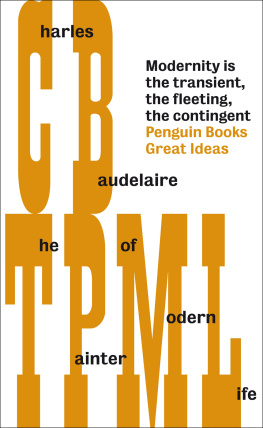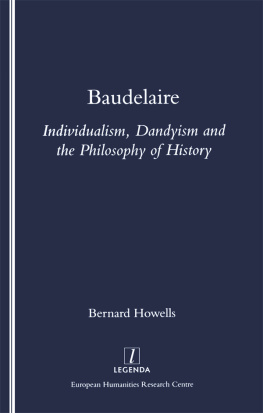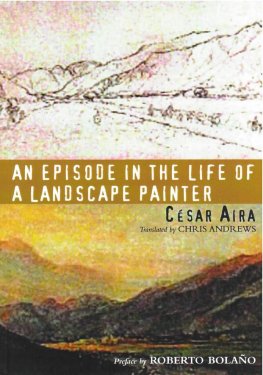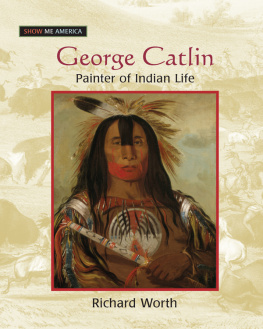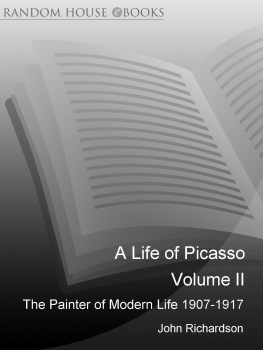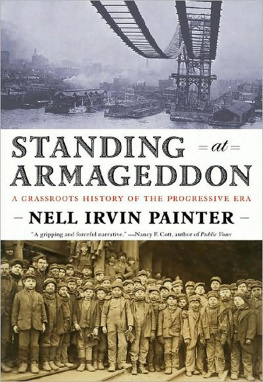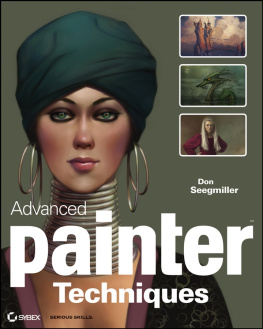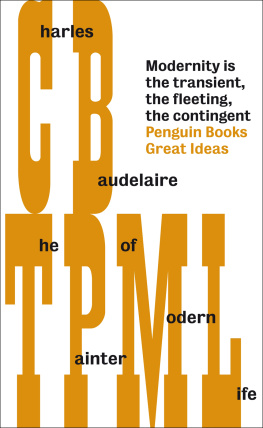Baudelaire Charles - The Painter of Modern Life
Here you can read online Baudelaire Charles - The Painter of Modern Life full text of the book (entire story) in english for free. Download pdf and epub, get meaning, cover and reviews about this ebook. City: France;Paris, year: 2010, publisher: Penguin Books Ltd, genre: Science. Description of the work, (preface) as well as reviews are available. Best literature library LitArk.com created for fans of good reading and offers a wide selection of genres:
Romance novel
Science fiction
Adventure
Detective
Science
History
Home and family
Prose
Art
Politics
Computer
Non-fiction
Religion
Business
Children
Humor
Choose a favorite category and find really read worthwhile books. Enjoy immersion in the world of imagination, feel the emotions of the characters or learn something new for yourself, make an fascinating discovery.
- Book:The Painter of Modern Life
- Author:
- Publisher:Penguin Books Ltd
- Genre:
- Year:2010
- City:France;Paris
- Rating:5 / 5
- Favourites:Add to favourites
- Your mark:
- 100
- 1
- 2
- 3
- 4
- 5
The Painter of Modern Life: summary, description and annotation
We offer to read an annotation, description, summary or preface (depends on what the author of the book "The Painter of Modern Life" wrote himself). If you haven't found the necessary information about the book — write in the comments, we will try to find it.
The Painter of Modern Life — read online for free the complete book (whole text) full work
Below is the text of the book, divided by pages. System saving the place of the last page read, allows you to conveniently read the book "The Painter of Modern Life" online for free, without having to search again every time where you left off. Put a bookmark, and you can go to the page where you finished reading at any time.
Font size:
Interval:
Bookmark:
Charles Baudelaire
TRANSLATED BY P. E. CHARVET
PENGUIN BOOKS GREAT IDEAS
PENGUIN BOOKS
Published by the Penguin Group
Penguin Books Ltd, 80 Strand, London WC2R 0RL , England
Penguin Group (USA) Inc., 375 Hudson Street, New York, New York 10014, USA
Penguin Group (Canada), 90 Eglinton Avenue East, Suite 700, Toronto, Ontario, Canada M4P 2Y3
(a division of Pearson Penguin Canada Inc.)
Penguin Ireland, 25 St Stephens Green, Dublin 2, Ireland (a division of Penguin Books Ltd)
Penguin Group (Australia), 250 Camberwell Road, Camberwell, Victoria 3124, Australia
(a division of Pearson Australia Group Pty Ltd)
Penguin Books India Pvt Ltd, 11 Community Centre, Panchsheel Park, New Delhi 110 017, India
Penguin Group (NZ), 67 Apollo Drive, Rosedale, North Shore 0632, New Zealand
(a division of Pearson New Zealand Ltd)
Penguin Books (South Africa) (Pty) Ltd, 24 Sturdee Avenue, Rosebank, Johannesburg 2196, South Africa
Penguin Books Ltd, Registered Offices: 80 Strand, London WC2R 0RL , England
www.penguin.com
Taken from Selected Writings on Art and Literature published by Penguin Classics
This selection published in Penguin Books 2010
Translation copyright P. E. Charvet, 1972
All rights reserved
Except in the United States of America, this book is sold subject to the condition that it shall not, by way of trade or otherwise, be lent, re-sold, hired out, or otherwise circulated without the publishers prior consent in any form of binding or cover other than that in which it is published and without a similar condition including this condition being imposed on the subsequent purchaser
ISBN: 978-0-14-195643-5
Charles Baudelaire
182167
In all social circles, and even in art circles, there are people who go to the Louvre, walk quickly past a large number of most interesting though secondary pictures, without throwing them so much as a look, and plant themselves, as though in a trance, in front of a Titian or a Raphael, one of those which the engravers art has particularly popularized; then they go out satisfied, as often as not saying to themselves: I know my gallery thoroughly. There are also people who, having once read Bossuet and Racine, think they have got the history of literature at their fingertips.
Happily from time to time knights errant step into the lists critics, art collectors, lovers of the arts, curious-minded idlers who assert that neither Raphael nor Racine has every secret, that minor poets have something to be said for them, substantial and delightful things to their credit, and finally that, however much we may like general beauty, which is expressed by the classical poets and artists, we nonetheless make a mistake to neglect particular beauty, the beauty of circumstance, the description of manners.
I am bound to admit that, for several years now, society has shown some improvement. The value that todays collectors attach to the delightful engraved and coloured trifles of the last century shows that a reaction has begun in the direction needed by the public; Debucourt, the Saint-Aubins and many others have achieved mention in the dictionary of artists worthy of study. But these represent the past, whereas my purpose at this moment is to discuss the painting of our contemporary social scene. The past is interesting, not only because of the beauty that the artists for whom it was the present were able to extract from it, but also as past, for its historical value. The same applies to the present. The pleasure we derive from the representation of the present is due, not only to the beauty it can be clothed in, but also to its essential quality of being the present.
I have here in front of me a series of fashion plates, the earliest dating from the Revolution, the most recent from the Consulate or thereabouts. These costumes, which many thoughtless people, the sort of people who are grave without true gravity, find highly amusing, have a double kind of charm, artistic and historical. They are very often beautiful and wittily drawn, but what to me is at least as important, and what I am glad to find in all or nearly all of them, is the moral attitude and the aesthetic value of the time. The idea of beauty that man creates for himself affects his whole attire, ruffles or stiffens his coat, gives curves or straight lines to his gestures and even, in process of time, subtly penetrates the very features of his face. Man comes in the end to look like his ideal image of himself. These engravings can be translated into beauty or ugliness: in ugliness they become caricatures; in beauty, antique statues.
The women who wore these dresses looked more or less like one or the other, according to the degree of poetry or vulgarity evident in their faces. The living substance gave suppleness to what appears too stiff to us. The viewers imagination can even today see a marching man in this tunic or the shrug of a womans shoulder beneath that shawl. One of these days perhaps some theatre or other will put on a play where we shall see a revival of the fashions in which our fathers thought themselves just as captivating as we ourselves think we are, in our modest garments (which also have their attractiveness, to be sure, but rather of a moral and spiritual kind); and, if they are worn and given life to by intelligent actors and actresses, we shall be surprised at our having laughed at them so thoughtlessly. The past, whilst retaining its ghostly piquancy, will recapture the light and movement of life, and become present.
If an impartially minded man were to look through the whole range of French fashions, one after the other, from the origins of France to the present day, he would find nothing to shock or even to surprise him. He would find the transition as fully prepared as in the scale of the animal kingdom. No gaps, hence no surprises. And if to the illustration representing each age he were to add the philosophic thought which that age was mainly preoccupied with or worried by, a thought which the illustration inevitably reflects, he would see what a deep harmony informs all the branches of history, and that, even in the centuries which appear to us the most outrageous and the most confused, the immortal appetite for beauty has always found satisfaction.
Here we have indeed a golden opportunity to establish a rational and historical theory of beauty, in contrast to the theory of a unique and absolute beauty, and to show that beauty is always and inevitably compounded of two elements, although the impression it conveys is one; for the difficulty we may experience in distinguishing the variable elements that go to make beautys unity of impression does not in any way invalidate the need of variety in its composition. Beauty is made up, on the one hand, of an element that is eternal and invariable, though to determine how much of it there is is extremely difficult, and, on the other, of a relative circumstantial element, which we may like to call, successively or at one and the same time, contemporaneity, fashion, morality, passion. Without this second element, which is like the amusing, teasing, appetite-whetting coating of the divine cake, the first element would be indigestible, tasteless, unadapted and inappropriate to human nature. I challenge anyone to find any sample whatsoever of beauty that does not contain these two elements.
Let me take as an example the two extreme stages of history. In hieratic art duality is evident at the first glance; the eternal element of beauty reveals itself only by permission and under the control of the religion the artist belongs to. In the most frivolous work of a sophisticated artist, belonging to one of those ages we vaingloriously call civilized, the duality is equally apparent; the eternal part of beauty will be both veiled and expressed, if not through fashion, then at least through the individual temperament of the artist. The duality of art is an inevitable consequence of the duality of man. If you like it that way, you may identify the eternally subsisting portion as the soul of art, and the variable element as its body. That is why Stendhal, that impertinent, teasing, even repugnant mind (whose impertinences are, nevertheless, usefully thought-provoking), came close to the truth, much closer than many other people, when he said: The beautiful is neither more nor less than the promise of happiness. No doubt this definition oversteps the mark; it subordinates beauty much too much to the infinitely variable ideal of happiness; it divests beauty too lightly of its aristocratic character; but it has the great merit of getting away from the mistake of the academicians.
Next pageFont size:
Interval:
Bookmark:
Similar books «The Painter of Modern Life»
Look at similar books to The Painter of Modern Life. We have selected literature similar in name and meaning in the hope of providing readers with more options to find new, interesting, not yet read works.
Discussion, reviews of the book The Painter of Modern Life and just readers' own opinions. Leave your comments, write what you think about the work, its meaning or the main characters. Specify what exactly you liked and what you didn't like, and why you think so.

